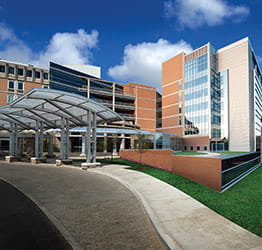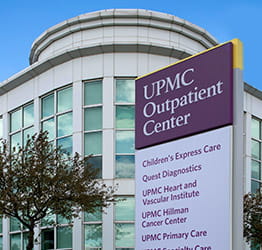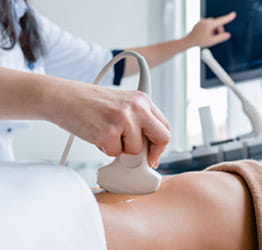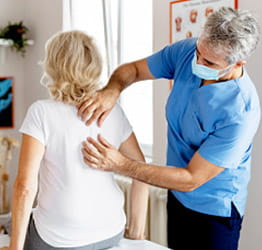On this page
What Is Angina (Chest Pain)?
Angina is chest pain that happens when an area of your heart doesn't get enough blood flow. It feels like a squeezing in your chest. It can also cause pain in your shoulders, neck, back, arms, or jaw.
Angina isn't a disease. Instead, it's a symptom of an underlying heart problem, most often coronary artery disease (CAD) or coronary microvascular disease.
CAD happens when plaque builds up in your arteries, reducing blood flow to your heart. That lack of blood flow causes angina.
As many as 7 million people in the U.S. may have angina. It affects men and women equally.
The UPMC Heart and Vascular Institute provides complete angina care — from screening to diagnosis to treatment and recovery. Our experts work as a team to care for you and empower you to live a heart-healthy life.
What are the types of angina?
There are four main types of angina:
-
Stable (angina pectoris) – This is the most common type of angina. It happens when your heart muscle is working harder than normal. The pain and severity occur in a regular pattern.
-
Unstable – This type of angina needs emergency treatment. The pain may become severe, and it's unpredictable. It's a signal you may have a heart attack soon.
-
Variant – This rare type, caused by a spasm in your coronary artery, often happens when you're resting.
-
Microvascular – Another rare type, it may cause severe pain and last longer than other types of angina.
What can be mistaken for angina?
Several other conditions can be mistaken for angina, including:
- Anxiety and panic attacks.
- Chest inflammation caused by costochondritis or pericarditis.
- Digestive disorders, such as acid reflux (GERD or heartburn), indigestion, esophageal spasm, or gallbladder disease.
- Lung disorders, such as pneumonia or pulmonary embolism.
If you are unsure about the cause of your chest pain or think you may be having a heart attack, you should dial 911 or go to the nearest hospital Emergency Department.
What causes angina?
Angina occurs when the heart doesn't receive enough blood flow. This often happens because of CAD. When arteries narrow from plaque buildup, blood can't flow through them as easily.
Certain factors can damage the arteries, causing plaque to build up. This means less blood can flow to the heart.
What are angina risk factors and complications?
Certain factors can put you at a higher risk of angina, such as:
-
Age – People older than 60 are more likely to get angina.
- Certain medications – Some drugs can cause blood vessels to tighten. Ask your doctor about the ones you take.
- Chronic kidney disease – This can put you at an increased risk of angina.
- Diabetes – People with diabetes are at an increased risk of CAD.
-
Family history – If you have parents or siblings who have had heart disease or a heart attack, there's a chance you're at higher risk.
- High blood pressure – High blood pressure can cause damage to arteries and speed up hardening over time.
- High cholesterol – High levels of bad cholesterol or triglycerides can lead to the arteries narrowing.
- Obesity – Excess weight means your heart works harder to send blood to the body and increases your risk of heart disease.
- Sedentary lifestyle – Being inactive increases your risk for heart disease and puts you at a higher risk of chest pain.
-
Smoking or tobacco use – Tobacco use or long-term secondhand smoke exposure can damage arteries, reducing blood flow.
- Stress – Too much stress can increase blood pressure and cause arteries to narrow.
-
Weather – Cold weather can cause a type of chest pain called Prinzmetal angina.
Back to top
What Are The Signs and Symptoms of Angina?
Angina often feels like a squeezing, tightening, or burning in the chest behind the breastbone.
Where is angina pain located?
Pain from angina usually occurs in the chest.
You may also have pain in the:
- Arms.
- Back.
- Jaw.
- Neck or throat.
- Shoulder.
The pain may feel like indigestion.
What does unstable angina feel like?
Unstable angina may feel like pressure, tightness, or a squeezing sensation in your chest. These sensations may spread to other areas of your upper body.
Other symptoms of angina include:
- Fatigue.
- Lightheadedness.
- Nausea.
- Shortness of breath.
- Sweating.
- Weakness.
Symptoms may happen during physical exertion or at rest.
How do I know if I am experiencing angina?
It can be difficult to tell if you are experiencing angina or another health condition, such as anxiety or a heart attack.
If you have chest pain that is new, gets worse, happens frequently, or doesn't respond to medication or rest, you should schedule an appointment with your doctor. If you experience severe symptoms, dial 911 or go to the nearest hospital Emergency Department.
What's the difference between chest pain and angina?
Chest pain can be caused by cardiac, digestive, inflammatory, lung, and mental health conditions. Angina is a specific type of chest pain that occurs when your heart muscle isn't getting enough blood.
Is
angina like a mini heart attack?
Angina is a symptom of coronary artery disease, which causes reduced blood flow to your heart. Although angina can be a sign that you are at risk of a heart attack, it usually happens during exertion and goes away with rest or medication. Heart attack symptoms do not go away with rest or medication.
How long do angina attacks last?
Angina attacks usually last less than 15 minutes and often happen during exercise or exertion. Symptoms usually improve with rest or after taking a medication called nitroglycerin.

Angina symptoms in women
Women's angina symptoms may differ from those of men.
What does angina in a woman feel like?
Women may experience different angina symptoms than men, which can sometimes cause women to go undiagnosed and untreated. It's important for women to understand the signs and symptoms of heart disease and get early treatment to reduce their risk of complications. Although women have chest pain with angina, they're more likely to have other symptoms such as:
- Fatigue.
- Nausea.
- Pain in the neck, jaw, teeth, or back.
- Palpitations.
- Shortness of breath.
- Stabbing pain in the chest rather than a feeling of pressure.
- Stomach pain.
With stable angina, symptoms occur in a predictable pattern — mostly during exertion. Rest and medicine can relieve stable angina symptoms.
Other types of angina may cause symptoms even at rest, and medicine may or may not ease symptoms.
When should I see a doctor about my angina symptoms?
You should make an appointment with a doctor if you have:
- Chest pain or discomfort.
- Chest pressure.
- Shortness of breath.
- Dizziness.
See a doctor if your wearable device (an Apple Watch, for example) shows signs of heart rhythm changes.
Back to top
Does angina show up on ECG?
An electrocardiogram (ECG) can show signs of angina during an episode of chest pain. However, an ECG may not pick up signs of angina at rest. If your ECG is normal and your doctor suspects angina, you may need to have more tests, such as a stress test or coronary angiogram.
How Do You Diagnose Angina?
First, your doctor will give you a physical exam and ask about your symptoms and health history.
How do you confirm if you have angina?
Your doctor will perform a physical exam and ask you about your symptoms, family history, and heart disease risk factors.
Before confirming an angina diagnosis, your doctor will determine the cause of your chest pain and rule out a heart attack. Because angina is a symptom of heart disease, your doctor will look for signs of heart damage.
Your doctor will also diagnose what type of angina you have, either stable or unstable.
They may give you certain tests or order imaging scans, such as:
- Blood tests — Blood tests look for risk factors for heart disease.
- Chest x-ray — This test looks for signs of heart damage, lung disorders, or other health problems. A chest x-ray doesn't diagnose angina but may rule out other causes of chest pain.
- CT scans — A CT scan is a type of x-ray that looks for narrowing of the arteries.
- Electrocardiogram (ECG or EKG) — This test measures your heartbeat and your heart's electrical activity (rhythm). Your doctor will look for signs of heart damage from heart disease or a prior heart attack.
- Electrophysiology testing — These tests check heart rhythms and the heart's electrical activity.
-
Stress test — This test measures your heart's response to physical activity that requires your heart to pump harder and faster. The test looks for shortness of breath and abnormal changes in your heart rate, rhythm, or electrical activity.
Back to top
How Do You Treat Angina?
Your doctor will base your treatment on the type of angina you have.
The main goals of treatment for all types of angina are to lessen your chest pain and prevent a heart attack.
Lifestyle changes
Adjust your lifestyle to avoid triggers, such as:
- Eating smaller meals.
- Limiting stress.
- Slowing down or taking more breaks during exertion.
Making heart-healthy changes to prevent heart disease can also help you deal with chest pain, like:
- Eating a healthy diet rich in fruits and veggies. Limit salt and sugar intake.
- Exercising safely. Your doctor can guide you on exercises you can do that won't worsen your chest pain while keeping you healthy.
- Maintaining a healthy weight for your body type.
- Quitting smoking.
Can angina be cured by exercise?
No. Exercise under the supervision of a health care provider may help build exercise tolerance and reduce symptoms of angina over time, but it will not treat the coronary artery disease that causes angina symptoms.
What foods make angina worse?
Foods high in saturated and trans fats, added sugar, and sodium may contribute to heart disease. These foods can also make angina symptoms worse and increase the frequency of angina attacks.
What not to do when you have angina?
If you have angina, you should not:
- Eat large meals — Large meals can worsen angina symptoms.
- Ignore new, severe, worsening, or more frequent chest pain — Dial 911 or go to the nearest hospital Emergency Department.
- Overexert or stress yourself — Stop activities that cause chest pain, manage stress, and follow your doctor's instructions for rest and medication.
- Smoke — Smoking can increase your risk of angina and heart attack.
Cardiac rehab
A rehab program helps you make the lifestyle changes you need to protect your heart.
You'll learn exercises to increase strength, endurance, and energy, and get advice and support for diet changes.
Medicine to treat angina
Medicine is a mainstay for stable and unstable types of angina.
Nitrates are the most common medications. Nitrates relax and widen your blood vessels to get more blood flow to your heart.
Your doctor may prescribe other drugs to:
- Lessen the strain on your heart.
- Lower blood pressure.
- Prevent blood clots.
- Relax blood vessels.
- Slow your heart rate.
These drugs include:
- ACE inhibitors.
- Beta-blockers.
- Blood thinners.
- Calcium channel blockers.
- Oral antiplatelets.
Surgery for angina
If medicine and lifestyle changes aren't enough, you may need other treatment methods for your heart disease.
These include:
-
Angioplasty — Surgeons thread a thin tube through a blood vessel and inflate the end to open the artery and improve blood flow. Your surgeon may place a stent in the artery to keep it open.
- Coronary artery bypass grafting (CABG) — Surgeons take healthy arteries or veins from another part of your body and use them to bypass the blocked artery.
Back to top
Can angina go away on its own?
No. Angina will not go away on its own. Although a stable angina attack may get better with rest, the condition is likely to recur without treatment.
What is the life expectancy of someone with angina?
Life expectancy with angina depends on your age, overall health, and the severity of your condition. Your doctor will discuss your life expectancy with you.
How can you tell if you have heart problems early?
Angina can be a warning sign of heart problems, such as coronary artery disease.
Other early signs of heart problems include:
- Chest pain.
- Dizziness.
- Fatigue.
- Heart palpitations.
- Shortness of breath.
How to tell if chest pain is heart-related?
It can be difficult to tell if chest pain is heart-related based on symptoms alone. If you aren't sure if your chest pain is heart-related, dial 911 or go to the nearest hospital Emergency Department.
Back to top
By UPMC Editorial Staff. Last reviewed on 2024-10-01.

















